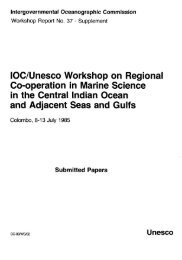Manual on sea level measurement and ... - unesdoc - Unesco
Manual on sea level measurement and ... - unesdoc - Unesco
Manual on sea level measurement and ... - unesdoc - Unesco
- No tags were found...
Create successful ePaper yourself
Turn your PDF publications into a flip-book with our unique Google optimized e-Paper software.
Sea Level Measurement <strong>and</strong> Interpretati<strong>on</strong>output from a range of sensors, including radar <strong>and</strong>pressure types. The data are collected by a small Linuxembeddedprocessor <strong>and</strong> sent back to base by e-mailor by secure copy protocol (SCP). Broadb<strong>and</strong>-enabledtest sites using a radar sensor c<strong>on</strong>nected to an embeddedLinux system have been installed at Liverpool <strong>and</strong>Holyhead in the UK. One-minute data values are availableevery five minutes in the form of an e-mail message.The resulting data are displayed <strong>on</strong> the NTSLFweb pages: http://www.pol.ac.uk/ntslf/networks.html.Over the last 6 years the Spanish Ports Authority(Puertos del Estado) has also been using e-mail/ftp datatransmissi<strong>on</strong> from harbour gauges to a PC. Future <strong>sea</strong><strong>level</strong> stati<strong>on</strong>s will communicate via embedded Linuxbasedsystems instead of Windows based PCs.The advantages of broadb<strong>and</strong> technology are:• C<strong>on</strong>tinuous two-way c<strong>on</strong>necti<strong>on</strong> allowing highspeeddata sampling <strong>and</strong> near-real-time data retrieval.Remote gauge diagnostics are available <strong>and</strong> theability to re-programme the system remotely.• Timing drift <strong>and</strong> operator setup error eliminated byhaving accurate time available from network timeprotocol (NTP) servers <strong>on</strong> the internet.• Data delivery costs are known up-fr<strong>on</strong>t, because thesubscripti<strong>on</strong> costs are paid m<strong>on</strong>thly or yearly.• Real-time data collecti<strong>on</strong> allows malfuncti<strong>on</strong>s to befound <strong>and</strong> fixed, more rapidly.• Fixed-line broadb<strong>and</strong> systems can also allow backupaccess through a dial-up modem.The disadvantages of broadb<strong>and</strong> technology are:• A LAN interface is required; this is often difficult toadd to existing tide gauge systems. A l<strong>and</strong> line isnecessary for n<strong>on</strong>-satellite broadb<strong>and</strong> systems.• Serial port is generally not available, so interfacingis more difficult.• Power requirement for broadb<strong>and</strong> modems is quitehigh (~1 amp), this can create problems wheremains power is not available.The following list provides a summary of satellitesystems/services that are being applied or c<strong>on</strong>sideredfor applicati<strong>on</strong> by some members of the <strong>sea</strong> <strong>level</strong> <strong>and</strong>geodetic community for the transmissi<strong>on</strong> of <strong>sea</strong> <strong>level</strong><strong>and</strong> GPS data:The INMARSAT/BGAN (Broadb<strong>and</strong> Global Area Network)service (www.inmarsat.com) began with the launch of F1<strong>and</strong> F2 INMARSAT-4 (at 64°E <strong>and</strong> 53°W respectively) in2005. These satellite cover Europe, Africa, Asia (partly) <strong>and</strong>Americas <strong>and</strong> will eventually be joined by a third satellite,F3 I-4 (178°E) to give virtually full world coverage. Presently,broadb<strong>and</strong> speed of 492 kbits/s is available with a static IPaddress. C<strong>on</strong>necti<strong>on</strong> is by LAN, USB or Bluetooth; there isno serial port c<strong>on</strong>necti<strong>on</strong>. Instruments interfaced to thisterminal unit will need a network c<strong>on</strong>necti<strong>on</strong>.BGAN is a drop-in replacement for l<strong>and</strong>-line broadb<strong>and</strong>modems. It shares most of the advantages <strong>and</strong> disadvantagesof c<strong>on</strong>venti<strong>on</strong>al broadb<strong>and</strong>, but is capableof operating in remote areas <strong>and</strong> is optimized for lowpoweroperati<strong>on</strong>. BGAN’s biggest advantage over fixedlinebroadb<strong>and</strong> is its independence of local teleph<strong>on</strong>einfrastructure, <strong>and</strong> during extreme c<strong>on</strong>diti<strong>on</strong>s it will mostlikely c<strong>on</strong>tinue operating.GLOBALSTAR (www.globalstar.com/en/works/ <strong>and</strong> www.globalstar.com/en/c<strong>on</strong>tact.php) is a commercial globalsatellite teleph<strong>on</strong>e service based <strong>on</strong> 40 LEO satellites.The network is capable of picking up signals from over80% of Earth’s surface outside extreme polar regi<strong>on</strong>s<strong>and</strong> some mid-ocean regi<strong>on</strong>s. The system offers voice<strong>and</strong> data transmissi<strong>on</strong> via a secure code divisi<strong>on</strong> multiple-access(CDMA) satellite signal; there is no perceptiblevoice delay. There is sufficient back-up in the system toprevent call interrupti<strong>on</strong>. Signals are distributed to existingfixed or local cellular-ph<strong>on</strong>e networks in over 120countries.IRIDIUM (www.iridium.com; <strong>and</strong> www.deltawavecomm.com which is a service provider for Iridium <strong>and</strong> othersystems) is a similar type of system to that of Globalstar,but claims ‘complete coverage (including oceans, airways<strong>and</strong> polar regi<strong>on</strong>s)’. It comprises a ‘fleet’ of 66 LEOsatellites operating in a fully-meshed network. It serves awide range of commercial, governmental <strong>and</strong> social sectors<strong>and</strong> designs <strong>and</strong> sells its own equipment through aworld-wide network of more than 100 partners. Iridiumspecifically offers data-transmissi<strong>on</strong> services via laptop<strong>and</strong> cellph<strong>on</strong>e world-wide, including very remote areas.ORBCOMM (www.orbcomm.com) c<strong>on</strong>sists of a spacesegment of 36 LEO satellites with ground segmentscalled Gateway Earth Stati<strong>on</strong>s (GES) <strong>and</strong> GatewayC<strong>on</strong>trol Centres (GCC). From some areas communicati<strong>on</strong>scan be in near-real time. However, where areceiving satellite cannot communicate with a GES <strong>and</strong>a subscriber simultaneously, ORBCOMM operates inGlobalgram mode. In this mode the subscriber data arerelayed through a GES <strong>and</strong> GCC to an Internet ServiceProvider <strong>and</strong> there may be a delay of several hours inreceiving data. For much of Africa <strong>and</strong> the Indian Ocean,the Globalgram mode is the <strong>on</strong>ly opti<strong>on</strong>.VSAT (Very Small Aperture Terminal) (www.vsat-systems.com) satellite terminals are comm<strong>on</strong>ly used by the geodeticcommunity for communicati<strong>on</strong> at remote locati<strong>on</strong>s<strong>and</strong> via GPS stati<strong>on</strong>s co-located with tide gauges; theyare available for use in the C, Ka <strong>and</strong> Ku b<strong>and</strong>s. Datatransmissi<strong>on</strong>rates are up to several Mbits/s per terminal.For smaller data-transmissi<strong>on</strong> rates, VSATs are clustered ina network with a central hub for network c<strong>on</strong>trol. In thatway, the system capacity can be shared am<strong>on</strong>g varioususers (terminals). For VSAT systems, TDMA (time-divisi<strong>on</strong>multiple access) is probably the most comm<strong>on</strong> technique40IOC <str<strong>on</strong>g>Manual</str<strong>on</strong>g>s <strong>and</strong> Guides No 14 vol IV
















